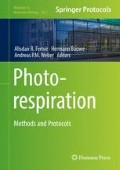Abstract
Cysteines are important residues for protein structure, function, and regulation. Owing to their modified reactivity, some cysteines can undergo very diverse redox posttranslational modifications, including the reversible formation of disulfide bonds, a widespread protein regulatory process as well exemplified in plant chloroplasts for Calvin-Benson cycle enzymes. Both core- and peripheral-photorespiratory enzymes possess conserved cysteines, some of which have been identified as being subject to oxidative modifications. This is not surprising considering their presence in subcellular compartments where the production of reactive species can be important. However, in most cases, the types of modifications and their biochemical effect on protein activity have not been validated, meaning that the possible impact of these modifications in a complex physiological context, such as photorespiration, remains obscure.
We here describe a detailed set of protocols for alkylation methods that have been used so far to (1) study the protein cysteine redox state either in vitro by submitting purified recombinant proteins to reducing/oxidation treatments or in vivo by western blots on protein extracts from plants subject to environmental constraints, and its dependency on the two major reducing systems in the cell, i.e., the thioredoxin and glutathione/glutaredoxin systems, and (2) determine two key redox parameters, i.e., the cysteine pK a and the redox midpoint potential.
Access this chapter
Tax calculation will be finalised at checkout
Purchases are for personal use only
References
Poole LB (2015) The basics of thiols and cysteines in redox biology and chemistry. Free Radic Biol Med 80:148–157
Couturier J, Chibani K, Jacquot JP, Rouhier N (2013) Cysteine-based redox regulation and signaling in plants. Front Plant Sci 4:105
Biteau B, Labarre J, Toledano MB (2003) ATP-dependent reduction of cysteine-sulphinic acid by S. cerevisiae sulphiredoxin. Nature 425:980–984
Michelet L, Zaffagnini M, Morisse S, Sparla F, Perez-Perez ME, Francia F et al (2013) Redox regulation of the Calvin-Benson cycle: something old, something new. Front Plant Sci 4:470
Appenzeller-Herzog C, Ellgaard L (2008) In vivo reduction-oxidation state of protein disulfide isomerase: the two active sites independently occur in the reduced and oxidized forms. Antioxid Redox Signal 10:55–64
Cho SH, Porat A, Ye J, Beckwith J (2007) Redox-active cysteines of a membrane electron transporter DsbD show dual compartment accessibility. EMBO J 26:3509–3520
Lu H, Allen S, Wardleworth L, Savory P, Tokatlidis K (2004) Functional TIM10 chaperone assembly is redox-regulated in vivo. J Biol Chem 279:18952–18958
Chibani K, Tarrago L, Schürmann P, Jacquot JP, Rouhier N (2011) Biochemical properties of poplar thioredoxin z. FEBS Lett 585:1077–1081
Couturier J, HC W, Dhalleine T, Pégeot H, Sudre D, Gualberto JM et al (2014) Monothiol glutaredoxin-BolA interactions: redox control of Arabidopsis thaliana BolA2 and SufE1. Mol Plant 7:187–205
Parent A, Elduque X, Cornu D, Belot L, Le Caer JP, Grandas A et al (2015) Mammalian frataxin directly enhances sulfur transfer of NFS1 persulfide to both ISCU and free thiols. Nat Commun 6:5686
Hara S, Nojima T, Seio K, Yoshida M, Hisabori T (2013) DNA-maleimide: an improved maleimide compound for electrophoresis-based titration of reactive thiols in a specific protein. Biochim Biophys Acta 1830:3077–3081
Shaikhali J, Davoine C, Brännström K, Rouhier N, Bygdell J, Björklund S, Wingsle G (2015) Biochemical and redox characterization of the mediator complex and its associated transcription factor GeBPL, a GLABROUS1 enhancer binding protein. Biochem J 468:385–400
Yoshida K, Hara S, Hisabori T (2015) Thioredoxin selectivity for thiol-based redox regulation of target proteins in chloroplasts. J Biol Chem 290:14278–14288
Keech O, Gardeström P, Kleczkowski LA, Rouhier N (2017) The redox control of photorespiration: from biochemical and physiological aspects to biotechnological considerations. Plant Cell Environ. 40:553–569
Navrot N, Collin V, Gualberto J, Gelhaye E, Hirasawa M, Rey P et al (2006) Plant glutathione peroxidases are functional peroxiredoxins distributed in several subcellular compartments and regulated during biotic and abiotic stresses. Plant Physiol 142:1364–1379
Acknowledgments
The UMR1136 is supported by a grant overseen by the French National Research Agency (ANR) as part of the “Investissements d’Avenir” program (ANR-11-LABX-0002-01, Lab of Excellence ARBRE). The Swedish Research Council “VetenskapsRådet” (grant: 621-2014-4688) as well as the Kempe Foundations are acknowledged for their financial support to O.K.
Author information
Authors and Affiliations
Corresponding author
Editor information
Editors and Affiliations
Rights and permissions
Copyright information
© 2017 Springer Science+Business Media LLC
About this protocol
Cite this protocol
Zannini, F., Couturier, J., Keech, O., Rouhier, N. (2017). In Vitro Alkylation Methods for Assessing the Protein Redox State. In: Fernie, A., Bauwe, H., Weber, A. (eds) Photorespiration. Methods in Molecular Biology, vol 1653. Humana Press, New York, NY. https://doi.org/10.1007/978-1-4939-7225-8_4
Download citation
DOI: https://doi.org/10.1007/978-1-4939-7225-8_4
Published:
Publisher Name: Humana Press, New York, NY
Print ISBN: 978-1-4939-7224-1
Online ISBN: 978-1-4939-7225-8
eBook Packages: Springer Protocols

